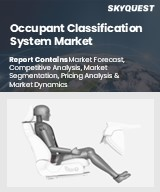
세계의 탑승자 분류 시스템 시장 규모는 2023년에 42억 달러로 평가되며, 2024년 43억 9,000만 달러에서 2032년에는 62억 4,000만 달러로 성장하며, 예측 기간(2025-2032년)의 CAGR은 4.5%로 성장할 전망입니다.
세계 탑승자 분류 시스템(OCS) 시장은 안전 규제 강화, 승객 보호에 대한 요구 증가, 대중 차량에 OCS의 통합으로 인해 강력한 성장세를 보이고 있습니다. 소비자의 기대와 엄격한 규제 프레임워크에 힘입어 첨단 차량용 안전 기능에 대한 수요가 크게 증가하고 있습니다. 특히 AI 기반 센싱 및 센서 융합 분야의 기술 발전은 시스템의 정확도를 높이고, 경제형 및 중형차로의 적용을 지원합니다. 전기자동차와 자율주행차의 등장은 효과적인 탑승자 감지 시스템의 필요성을 더욱 높이고 있습니다. 그러나 이 시장은 고급 센서의 높은 비용, 규제의 복잡성, 데이터 프라이버시 우려 등의 문제에 직면해 있으며, 이는 보급의 걸림돌로 작용하여 자동차 업계 제조업체의 컴플라이언스 장애물이 될 수 있습니다.
Global Occupant Classification System Market size was valued at USD 4.2 billion in 2023 and is poised to grow from USD 4.39 billion in 2024 to USD 6.24 billion by 2032, growing at a CAGR of 4.5% during the forecast period (2025-2032).
The global occupant classification system (OCS) market is witnessing robust growth driven by heightened safety regulations, increased passenger protection needs, and the integration of OCS in mass-market vehicles. The demand for advanced in-vehicle safety features, propelled by consumer expectations and stringent regulatory frameworks, is a significant factor. Technological advancements, particularly in AI-based sensing and sensor fusion, enhance system accuracy and support deployment in economy and mid-segment vehicles. The rise of electric and autonomous vehicles further amplifies the necessity for effective occupant detection systems. However, the market faces challenges such as the high costs of sophisticated sensors, regulatory complexities, and data privacy concerns, which may hinder widespread adoption and create compliance hurdles for manufacturers in the automotive industry.
Top-down and bottom-up approaches were used to estimate and validate the size of the Global Occupant Classification System market and to estimate the size of various other dependent submarkets. The research methodology used to estimate the market size includes the following details: The key players in the market were identified through secondary research, and their market shares in the respective regions were determined through primary and secondary research. This entire procedure includes the study of the annual and financial reports of the top market players and extensive interviews for key insights from industry leaders such as CEOs, VPs, directors, and marketing executives. All percentage shares split, and breakdowns were determined using secondary sources and verified through Primary sources. All possible parameters that affect the markets covered in this research study have been accounted for, viewed in extensive detail, verified through primary research, and analyzed to get the final quantitative and qualitative data.
Global Occupant Classification System Market Segments Analysis
Global Occupant Classification System Market is segmented by Technology, Component, End Use, Applications and region. Based on Technology, the market is segmented into Sensor-Based Systems, Pressure-Based Systems, Weight Classification Systems and Infrared Detection Systems. Based on Component, the market is segmented into Sensors, Microcontrollers, Software and Algorithms. Based on End Use, the market is segmented into OEMs and Aftermarket. Based on Applications, the market is segmented into Passenger Vehicles, Commercial Vehicles, Motorcycles and Heavy-Duty vehicles. Based on region, the market is segmented into North America, Europe, Asia Pacific, Latin America and Middle East & Africa.
Driver of the Global Occupant Classification System Market
The increasing enforcement of stringent safety regulations worldwide is propelling manufacturers to integrate sophisticated occupant classification systems. Compliance with standards like Euro NCAP and FMVSS requires precise occupant detection for the proper deployment of airbags, making the adoption of occupant classification systems essential. This commitment to enhanced safety measures not only helps manufacturers adhere to evolving regulatory demands but also significantly bolsters passenger protection. As the global automotive market continues to adapt to these changing requirements, the implementation of advanced occupant classification technology becomes a critical driver for industry growth and sustainability.
Restraints in the Global Occupant Classification System Market
Significant challenges in the occupant classification system market arise from the prohibitive costs associated with advanced sensors and artificial intelligence integration, hindering their implementation in more affordable vehicles. Manufacturers face the dilemma of balancing affordability with compliance to regulatory standards, which impacts the overall market potential for occupant classification systems. This dynamic results in limited adoption of sophisticated occupant detection technologies within budget-friendly car segments, ultimately slowing down the growth and expansion of these advanced systems across a broader range of vehicles. Consequently, this restraint may delay the widespread acceptance and utilization of innovative occupant safety solutions.
Market Trends of the Global Occupant Classification System Market
The Global Occupant Classification System market is experiencing a significant trend towards AI-powered adaptive sensing technologies, which enhance occupant safety by learning and adapting to individual behavior and posture patterns. This intelligent integration enables precise airbag deployment and customized safety responses, aligning with the automotive industry's shift towards increasingly sophisticated and personalized cabin safety solutions. As automakers prioritize advanced safety features across a broad spectrum of vehicles, both mass-market and premium segments are seeing rising adoption rates of AI-based occupant classification systems. This evolution underscores a growing commitment to leveraging technology for improved vehicle safety and occupant protection.